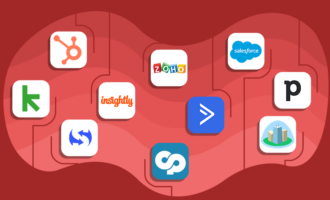Retail banking is more competitive than ever. Empowered by smartphones and comparison sites, consumers are no longer beholden to a single bank for all their personal finance needs. Whether they’re looking for a credit card, mortgage, or personal loan, people are free to pick and choose from dozens of financial providers.
Banks need to keep up. In a competitive market, improving the customer experience through customer relationship management (CRM) is essential. Here’s why CRM in banking is the answer.
CRM in a banking context
A CRM solution in a banking context is the same as in any other B2C or B2B business — it’s a tool that helps businesses manage customer relationships and better understand their needs.
CRMs can connect dozens of siloed public and private data sources — like social media, web analytics, and sales — to create a comprehensive view of individual customers and a bank’s target audience as a whole.
But CRMs are far from common in most banks, says James Gilbert, chief marketing officer at voice assistant provider RedRoute. “Traditionally, banks and credit unions have adapted their core systems in the absence of a true customer relationship management (CRM) system,” he writes. “But these core systems were never engineered to be a CRM and, in a lot of cases, existing core systems don’t have the necessary integration points to ensure a seamless employee and customer experience – which results in friction points developing between departments.”
That needs to change. With 89 percent of US consumers using mobile banking channels and 70 percent saying it’s their main method for accessing their accounts — according to a report by Insider Intelligence — leveraging data to better serve customers will be vital going forward.
The benefits of CRM in banking branches
It’s not just a case of keeping pace with changing consumer trends. Integrating a CRM into your bank comes with a stack of benefits:
- More sales: CRMs make it easier to identify, nurture, and convert leads for a range of banking products.
- Better customer interactions: When you have all of your customer data at your fingertips, it’s easier to deliver a more meaningful experience.
- Personalization: You can combine CRM data with marketing personalization tools to tailor your campaigns to individual customers.
- Increased productivity: Collating all your customer data in one place makes it easier to find the data you need and act on it.
- Better inter-department collaboration: A CRM removes data siloing, allowing teams access to the same data sets.
A banking CRM: How to build one with Jotform
There’s a range of CRM solutions on the market, from complicated and expensive heavyweight solutions to lightweight ones. Then there’s Jotform.
Jotform’s combination of digital forms, shareable tables, and templates makes it easy to create an efficient and cost-effective CRM. You don’t even have to start from scratch. Jotform comes with a number of CRM templates that banks can use to keep track of every customer.
Collect the data you need using one of Jotform’s pre-designed banking forms. From loan applications to bank account registration forms and even identity verification checks, you can find everything you need to collect data for your bank, and you can automatically store it in your CRM.
Automation is a key part of any CRM, and Jotform has that covered. You can create approval workflows to automate processes every time someone submits a form. For instance, that could see every credit application automatically sent to the relevant employee. You can also forward approvals to other employees for additional sign-offs. Then you can set up an automatic and personalized email to go to the customer after your team approves or declines the application.
You don’t have to use Jotform as your sole CRM, however. The platform integrates with several notable CRM solutions, including HubSpot, Pipedrive, and Zoho CRM. When you connect Jotform with one of these solutions, you can use it as a powerful information-gathering tool. You can collect data from customers using one of our premade templates and have your CRM automatically pull that data into your database.
When choosing a CRM for your bank, consider a range of factors, including price, features, and ease of use. Every CRM is different, but the right one will make improving your customers’ experiences easy.
Photo by Kampus Production


























































Send Comment: